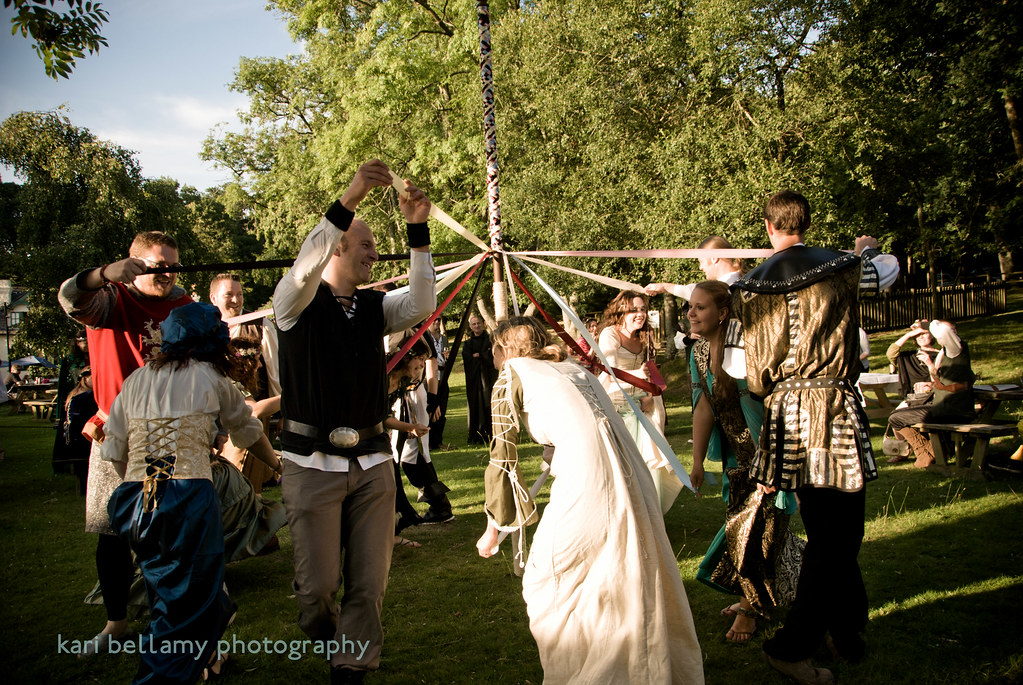
Hooray! You've been invited to a pagan wedding! We're so excited for you. That said, depending on your background or your beliefs, you might feel a little confused. What's in store? Why is everyone standing in a circle? Are we talking about gods?
Well, first thing's first, I highly recommend reading the Offbeat Bride guide to Pagan Weddings. That post will give you some ideas about what's going on.
But today, I want to talk about aspects of a pagan wedding that could feel unfamiliar to guests who've never attended one before…

Folks tend to stand or sit in a circle for Pagan rituals
So don't be surprised to find this sort of seating arrangement. While standing is common, if you need to sit, don't be afraid to ask for a chair before things get started (or better yet, when you RSVP). It's likely that you won't be the only person who needs a chair.
A common practice is the blessing of the space wherein the ritual is being held
This could be done by burning incense, ringing bells, banging drums, sprinkling sacred water, walking around the space to “cast the circle,” or tossing flower petals and herbs. The purpose of this is simple: the ancient marble temples are now crumbling tourist traps. So, modern Pagans often hold their rituals where they can, and make the ritual area holy or blessed as needed. It can also be done to drive out any negative energies from the area, including those that people may bring with them, such as wedding planning stress.
There may be a mention of something along the lines of “our/the gods”
Which you can consider to be including your own, if you have any. Keep in mind that no-one expects you to join in on any prayers.
The elements of earth, air, water, and fire may be invited or spoken of
These are symbolic of the basic building blocks of life and creation. The air we breathe, the water in the oceans, and so forth. The elements can also symbolize certain concepts: earth for the physicality, air for intellect, water for emotions, and fire for passion.
You may hear Pagan phrases you're unfamiliar with
Some common Pagan phrases include:
- “blessed be” and “hail,” which are similar to “amen” or “cheers.”
- “Merry meet” and “merry part” are greetings that are often used at the start and end of rituals.
- “So mote/may it be” is an affirmation and indication of agreement.
Paganism is more family-friendly than most people may think
It's not uncommon to see children (and even dogs) moving about the ritual space, sitting on the ground, nursing in mother's arms, and joining in as is age-appropriate.
The actual tying of hands using ribbon or cords
In its simplest form, a handfasting is the binding of a couple's hands or wrists together as a unity ritual within the ceremony. This can be done a variety of ways: the couple may tie the knot themselves, it may be tied by the officiant, or by friends and family of the couple. This is typically the main section of a Pagan wedding and can incorporate the exchanging of rings, speaking of the vows, or the blessing of the union. How long the cord remains physically tied is entirely up to the couple (a few brave souls even remain bound until they retire to their honeymoon suite).

Jumping over a broom is also a common practice
The wedding broom can be called by its old-timey name of “besom.” The broom symbolizes a few different things and the couple may choose to place emphasis on one or more for their ceremony. Brooms are often stored by the front or back door of the home, and thus a broom can symbolize a threshold, the line between the old single life and a new married life. This is similar to the tradition of carrying the bride across the threshold of a new home.
As brooms are used for cleaning and sweeping, it can symbolize the sweeping away of the old dirt of your past to start fresh. The handle of a broom is somewhat phallic in shape and the brush is shaped somewhat like a woman's skirt, so these two things combined can symbolize fertility and union. A broom also symbolizes the daily grind of marriage; that is, cleaning the floors, taking out the trash, making dinner, and caring for one another.
[Note from the editors: there has been some debate online about whether jumping the broom is a cultural appropriation of African American traditions. Based on our research, the tradition has several complex histories, including African Americans, Romani people, and Welsh roots. Ultimately, it's complicated — it's up to each couple to decide what feels right to them.]

There may be a Maypole Dance
This is another European folk tradition that has ancient Pagan roots. It is a tall pole with strings or ribbons attached at the top, and people dance or move around it, winding the ribbon around the pole as they go. It's usually a lot of fun and is accompanied by music, singing, and laughing when you realize that you're getting the steps wrong. The symbolism of the Maypole is a bit of a mystery even to historians.
To Pagans it can be a sacred tree, being dressed up and decorated. It can signify the “axis mundi,” the pillar that connects the heavens and the earth. It can have the meaning of union and fertility, in that a hole is dug and a pole is planted into the “womb of the earth” and it is then wrapped in beauty. It can be a symbol of marriage, as the pole is wrapped in colorful ribbon, similar to how the hands and wrists are bound during a handfasting.
The vows sworn may not be what you are accustomed to
Often, they are personal vows written by the people getting handfasted. (Here's one great example!) Such things as love, honour, or cherish and obey, may not be mentioned. The phrase “'till death do us part” may not be used, but instead replaced by the more realistic and modern concepts such as “for so long as our love shall last.”

Final thoughts for folks invited to a Pagan wedding
Pagans know how to throw a great party! Even if the ceremony itself seems very serious, you can expect good food, good people, and a lot of laughter during the reception. In truth, the ceremony is likely to be laid back, happy, and shorter than you might expect. Keep in mind that you may be offered food or drink, but you may politely turn anything down that you do not want.
It's just a wedding. Relax, sit back, and remember why you were invited in the first place: the people who invited you care about you and want you to be part of their special day.







